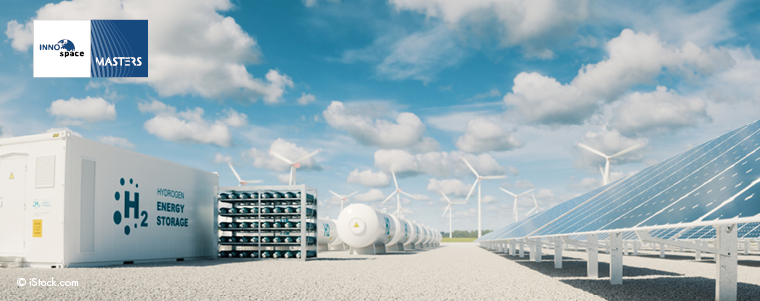
- 12. January 2022
Hydrogen – a key component in a sustainable energy system in space and on Earth
Designing a sustainable energy system is dependent on there being sufficient storage capacities available for green energies. To use energy resources efficiently and sustainably, surpluses from energy production must be stored and distributed geographically or staggered over time. Some promising possible solutions here are based on hydrogen as an energy source. The energy density and diverse applications of hydrogen have led hydrogen technologies to grow in demand and popularity in a wide range of areas.
Decentralised renewable energy production is an area of focus within innovative projects concerning the transformation of municipal energy supply systems. As a result, power-to-gas hydrogen storage systems are being used more and more frequently. Surpluses from solar power generation are converted into hydrogen and stored in such systems using electrolysis. Fuel cell technology makes this process reversible. Intelligent control systems use the hydrogen to produce electricity via the fuel cell where needed. This electricity can then be used efficiently and autonomously as an energy supply.
Autonomous energy systems are based on concepts and technologies that have above all been developed in space. For instance, the first modern fuel cell was developed by NASA for the Moon landings during the Apollo missions. It is the key to closed energy systems and was used during the Apollo missions to produce electricity (up to 2,300 watts per module), heat and drinking water.
Hydrogen is used as energy storage not only for manned spaceflight but also for satellites and probes. Solar energy has always been used to produce electricity. However, the energy must be stored in order to operate satellites in the shadow of the Earth or Moon. For a long time, conventional batteries were too heavy and bulky to fulfil the requirements in space.
The satellite only needs small quantities of hydrogen and oxygen as fuel in order to produce electricity in fuel cells. When electricity is produced using fuel cells, water is formed as a waste product and stored in corresponding tanks on board the satellite. Once the satellite emerges out of the shadow of a celestial body, the process is reversed. Solar rays are used to produce electricity via solar panels. This enables the water to once again be separated into hydrogen and oxygen by means of electrolysis. This closed energy cycle can thus be repeated almost indefinitely.
This technology has now also found its way into terrestrial industries, such as in municipal energy supply systems. The example of hydrogen technologies as a driver of innovation shows how important cross-industrial technology transfer is for innovation and how it can drive forward technological development in other sectors.
Hydrogen is now considered the key to a sustainable energy cycle on Earth.
To sustainably exploit the potential of hydrogen technologies, initiatives and programmes to develop the hydrogen infrastructure are being initiated both in Germany and abroad. Such initiatives aim to support innovations relating to the manufacture, storage, transport and use of hydrogen.
However, the use of hydrogen is only climate-friendly if it is produced from renewable energy sources. The most important process here is electrolysis, which is perfectly suitable for combining with wind power and photovoltaics. The initiative Green Hydrogen Catapult was launched in 2020 to support innovations relating to electrolysis on an industrial scale. Initiated by an industry consortium of leading hydrogen companies and with the support of the UN, the initiative aims to massively scale up the production of green hydrogen(1) by 2026. The increased availability of green hydrogen resulting from this should contribute towards transforming carbon-intensive industries around the world. This includes, for instance, electricity production, the chemicals industry, the steel industry and shipping. The initiative also aims to reduce costs by 50% (target price USD 2 per kg of green hydrogen) and create 80 GW of electrolysis capacity with systems powered by renewable electricity.
Hydrogen is a key component in a sustainable and future-oriented energy supply. This is not the only reason why the first element in the periodic table offers great business potential. Nevertheless, many innovations will also be required in all areas before a sustainable energy system can be designed. Promoting such innovations is the aim of the international innovation competition INNOspace Masters. With this year’s competition theme, the INNOspace Masters is looking for sustainable and efficient innovations for space and the Earth in five different Challenges.
This year’s DLR Challenge, organised by the German Space Agency, particularly focuses on innovations involving the transfer of hydrogen technologies between space and terrestrial industries. Project ideas are being sought that aim towards a sustainable, safe and efficient energy supply and mobility. Projects can, among other things, be based on the transfer of technologies for manned space stations or regenerative fuel cell systems for satellites and probes. Ideas relating to sustainable hydrogen production, hydrogen-powered heavy commercial vehicles and green hydrogen steelworks are also being sought.
The three best project ideas will each receive up to EUR 400,000 of project support. Alongside the German Space Agency in the DLR as the organiser, the industry partners Airbus, OHB, Mercedes-Benz AG and the German ESA Business Incubation Centres (BICs) are each also offering their own Challenges. You can find all of the Challenges and prizes here.
(1) Green hydrogen – hydrogen produced from water with electrolysers powered by clean renewable electricity
https://greenh2catapult.com/